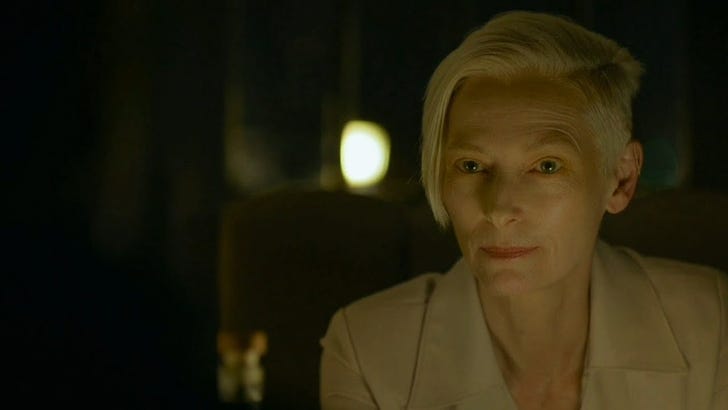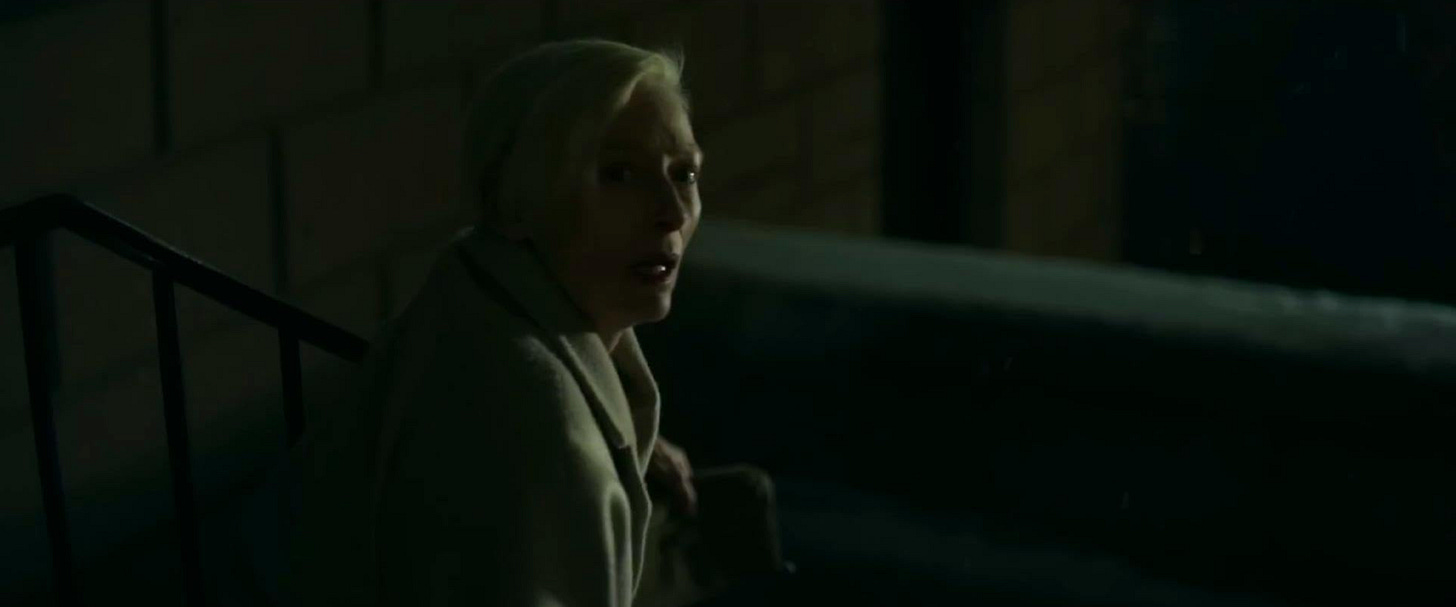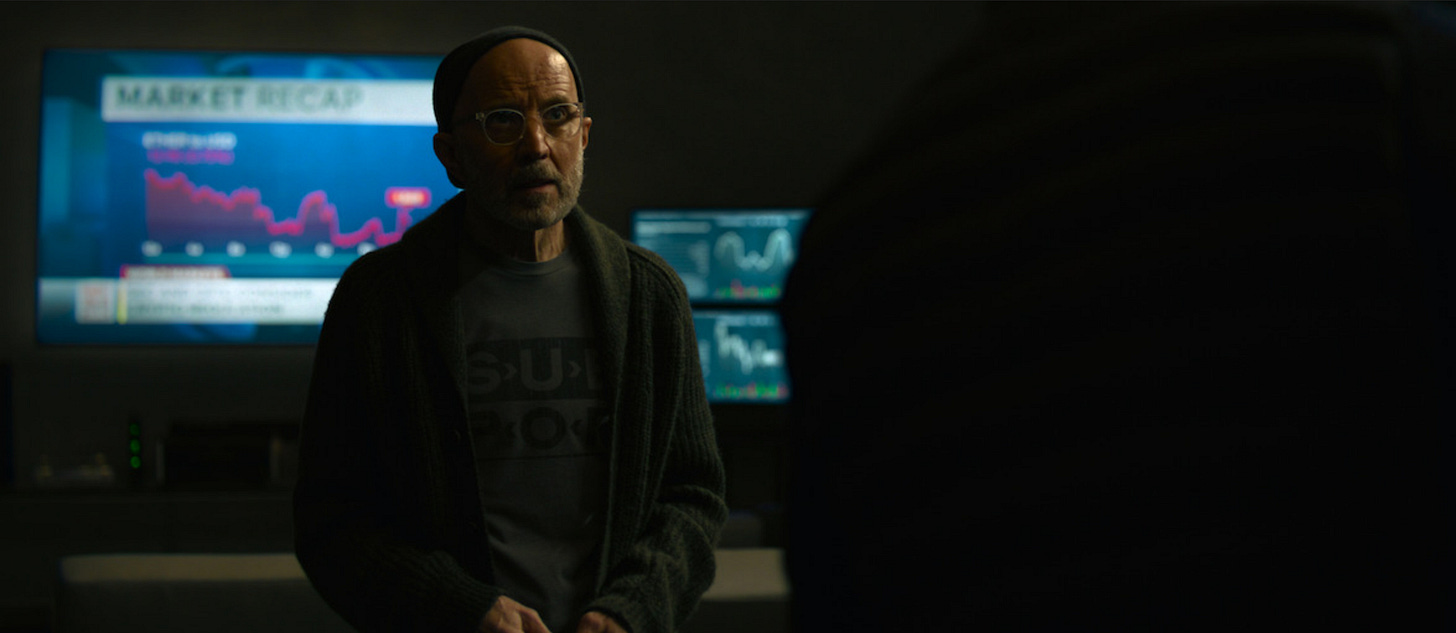Wild how all ”the boys are back in movie town” just as the whole biz is in total freefall eh? Scorsese, Mann, Anderson, Coppola, Nolan, Gerwig. Lots of “we’re back we’re so back” energy from a critical mass of big director names. You take what you can in this dog-eat-dog world.
Popeye the Sailor probably said it best: I am what I am. And I was a mark for David Fincher’s The Killer ever since word got out my man was cookin’ up a Don Siegel-esque hitman joint starring Michael Fassbender — the crystalline makings of Andycore cinema right there.
But what of the final product? Does The Killer translate as a modern gig-economy comedy? Straight-up techno-thriller that’s maybe too fussy for its own good? Or, as David Ehrlich put it, “a movie about how awesome and embarrassing it must be for a 60-year-old man to live with the fact that he directed Fight Club?”
By my line o’ sight, The Killer fires on all these cylinders and more. And what it shares with the other best film of 2023 (other than the word “killer” in the title) is it sort of contains everything about us in a highly emblematic, mass-distributed visual narrative. Killers of the Flower Moon pushes worlds past all genre constructions (some recognizable but distantly held narrative beats of the “Scorsese gangster picture” aside) to tell a true story of the killers we’ve always been. The Killer does the Brechtian thing of embodying and satirizing its chosen genre in equal measure, painting a vivid portrait of the killers we are now.
But don’t just take my word for it. There’s a whole galaxy of heavy-genre touchpoints out there to explain what The Killer’s doing and how it’s doing it. So whether you’ve seen it and thought it was just ok, already watched it repeatedly and obsessively like this sicko, or haven’t watched it at it all but might dig some classic thriller recs this time o’ year (and don't care about mild spoilers), enjoy this “whiskey flight” of six films (and one TV show, as a treat) to pair with each chapter of The Killer.
Body Double (1984)
Chapter 1 > The Target
The Killer’s first chapter is hard to beat—a new Hitchcockian portrait of failure seen through a Rear Window darkly. Fassbender’s The Killer waits to strike from an empty WeWork in Paris, setting the stage for the rest of the movie with unreliable voiceover narration, recalling Fight Club in its dorky Gen-X nihilism. “I’m not exceptional,” he says. “I’m just… apart.” He’s both a familiar movie psychopath and (by virtue of Fassbender’s metered, physical performance) an effective cipher — in his failure to hit the target, he broadcasts the inevitable, tired mediocrity that besets all gig workers in our techno-feudal era.
I am the son and the heir
Of a shyness that is criminally vulgar
I am the son and heir
Of nothing in particular
-The Smiths
I’ll never forgive Quentin Tarantino for calling my favorite movie a “toothless porn satire” in Cinema Speculation. From like the most famous and vocal De Palma stan too. SMH. By my count, Body Double is the most hilarious and sharp-toothed Hitchcockian portrait of failure from the director who made that his own perverted sub-genre. Craig Wasson hits an appropriately cipher-ish register as Jake, a struggling actor whose wicked case of claustrophobia gets him embroiled in a criminal conspiracy. In the film’s central rug-pull sequence, Jake plays willing voyeur and unwitting witness to a grizzly murder, all staged and captured through a leering telescope.
Body Double’s porn satire aspect totally works as porn satire, sure (just as the hitman-world parody of The Killer works as a dry, surface-level hitman parody). But go a few layers deeper and it becomes a sleazy Hollywood illusion about the illusion of Hollywood itself — Rear Window + Vertigo pitched to the tune of the ‘80s erotic thriller. A cryptic genre prophecy for all the hustlers and killers out here truckin’ through the final days of Reaganomics.
Charley Varrick (1973)
Chapter 2 > The Hideout
Forbid empathy. One of the Killer’s swiftly broken cardinal rules. Bound to slip up and get folks who love you maimed or killed when you’re the last of the independents.
“Even if you don’t think The Killer is conveying anything profound about the gig economy or its maker’s artistic process,” says Adam Nayman, “it’s still replete with honest, grotty pleasures.” For that, we can thank Don Siegel, straight up the patron saint of this movie dawg. Le Samouraï has been most touted as The Killer’s urtext, but “Let’s make a Don Siegel movie” was Fincher’s central edict here for sure. Not that artist intent is the end-all-be-all, but damn, you can really feel Siegel in the soup of this joint.
Exhibit A: Charley Varrick, a classic Siegel piece starring Walter Matthau as a low-rent independent bank robber. Varrick, his wife and buddies rob a small-town bank and come out with a heftier sum of money than expected—one that belongs to the mafia. Varrick loses his wife in the heist and the survival/revenge mission begins in all its grimy ‘70s earth-toned glory.
Mr. Inbetween (2018-2021)
Chapter 3 > The Lawyer
Our next chapter takes us to New Orleans, where good old Professor Hodges convinced me to stop studying law and start skirting it. The classic setup of the contract killer and the people in his small professional circle. Goin’ after the guy who raised you in the biz and all that.
I reckon something like 1972’s The Mechanic would be a more fitting pairing here, but fuck it, I’d rather improvise than anticipate. Mr. Inbetween is a criminally underrated Australian FX show about working-class hitman Ray Shoesmith, balancing criminal gigs and bosses with family responsibilities and other pedestrian concerns in the suburbs of Sydney. Think Barry if he weren’t a total antisocial maniac and more of a nice guy with a bit of a temper just trying to get by in these interesting times.
John Wick (2014)
Chapter 4 > The Brute
John Wick’s a bit of a thing around here. I recapped The Continental for Vulture this year and I ain’t even the most Wick-pilled one in the house. When we watch new movies, it’s wild how often my wife gets the opportunity to deliver her resounding thesis on modern cinema: “Everything is John Wick!” And I’ll be damned if The Killer’s gnarly showdown with The Brute ain’t Fincher tryna step in the ring with Wick director and genre-redefining action auteur Chad Stahelski. (If that’s the case, the whole presence of the guard dog in Chapter 4 and NOT killing that good boi is a fitting, dare I say reverent nod to the Baba Yaga.)
Every Wick fan has their own series ranking. I rank ‘em in straight reverse chronology: 4, 3, 2, 1. Still, the first Wick is probably most worth revisiting on this Killer flight—the launchpad and gold standard for every instance of home invasiony hand-to-hand combat, however well or poorly executed, in every action movie since.
Dirty Harry (1971)
Chapter 5 > The Expert
“You’re not really out here for the hunting, are you.” Tilda Swinton’s The Expert gets arguably the best punchline of the film, closing out the old joke about the hunter and the bear, uttered between slow, deliberate swigs of a whisky flight (her last meal). What are any of us in this devolving cat-and-mouse empire if not tired hunters doomed to the wrong end of a competitor’s rifle? Hunt or be hunted, that’s the game. Are we not men? We are K_.LLERS.
Don Siegel’s Dirty Harry is as fitting a touchpoint as any for the razor-thin lines separating the various killers—both actual and fictitious—who’ve haunted our collective imagination over the years. As we’re told in the trailer, “this is a movie about a couple of killers. The one with the badge is Harry.” Opposite our titular American homicidal detective is Scorpio (Andrew Robinson), an apparitional hybrid of Manson and Zodiac and “a true boogeyman for the reactionary right if there ever was one,” as I put it for Film Cred on the movie’s 50th anniversary:
Both characters are sort of entombed in their alienation from society, however self-imposed. Right at the midway point […] the two killers face off in the middle of an empty football field, creating one of the film’s most indelible images. If “crime is a disease,” Harry Callahan and Scorpio are the yin-yang demon-gods of American crime, locked in a barren, echoing gladiatorial arena, bleeding all over each other across hyperspace.
Diamonds Are Forever (1971)
Chapter 6 > The Client
Bond is a probably a few rings out on The Killer’s referential orbit. And sure, this ‘70s surrealist spy adventure isn’t the most tonally aligned with Fincher’s stripped-down approach to the genre. But Diamonds Are Forever is the Bond movie that, like The Killer, dares to ask: what if the world’s greatest supervillain were… a famous American billionaire?!
Diamonds’ convoluted evil world-domination plot was inspired by a dream of producer Albert R. Broccoli’s that Howard Hughes had been replaced by an imposter. Bond (Sean Connery, lookin’ a little worse for wear but no less charming n’ dangerous in his final official 007 outing) infiltrates a Las Vegas diamond-smuggling ring connected to Hughes stand-in Willard Whyte—eventually scaling the face of Whyte’s Vegas hotel via a wide-lapelled, grappling-lined tuxedo. Bond infiltrates the penthouse to discover his old arch nemesis, Ernst Stavro Blofeld, at Whyte’s desk, running the entire operation from a phone with a Willard Whyte voicebox. To make things more surreal, there’s a second fucking Blofeld (and accompanying fluffy white cat) in the room—a surgically-altered double who Bond kills by mistake, leaving the real Blofeld to be vanquished in the explosive finale.
“The copies of Blofeld in Diamonds can be stand-ins for Blofeld’s past,” says Kent M. Wilhelm. “It addresses the existence of multiple Blofelds and the fact they’re all, more-or-less, the same bad guy.” And ain’t that just the way with our real-life, tabloid-chasing modern billionaires, as personified in The Killer’s Sub Pop tee, beanie-adorned venture capitalist Henderson “Clay” Claybourne (Arliss Howard).
For our final chapter and setpiece (or anti-setpiece), The Killer infiltrates the big topical-billionaire baddie’s penthouse in Chicago via a late-stage McGyver-ish set of tools befitting the ugly cyberpunk hellworld of 2023. Sometimes, all you need is a fob copier from Amazon and an open garage door courtesy of Uber Eats ya know? Only there’s no grand arch-nemesis behind the boyish, banal evil that runs The Killer’s world. And there’s an immediate sense of inevitability to his decision to leave Claybourne unscathed. Gotta let the sleeping hounds of industry lie if you want to exit the gig economy for good. This is what it takes. What you must commit yourself to. If you want to succeed. Simple.
Thief (1981)
Epilogue
Michael Mann’s Thief has, as I put it for Film Cred, “pretty much everything you think of when you think of Mann — a lone-samurai-esque protagonist, cops and robbers, a propulsive synthy score, and lots of cold dark streets wet with rain and neon. [It’s] also a thoughtful, melancholy meditation on blue-collar burnout under late-stage capitalism.” Frank (James Caan) is a cracker-jack independent jewel thief who takes a high-stakes job with a Chicago mob boss, only to find the terms of their one-time deal have changed after the fact.
“I can see that my money is still in your pocket, which is from the yield of my labor.” Mann has said countless times that Frank is a walking manifestation of Karl Marx’s labor theory of value. So is The Killer. But where Frank the Thief takes the system down in a cold fury before walking off alone into the darkness, The Killer leaves the almighty house of dollars as is for a clean, secure getaway.
The need to feel secure is a slippery slope, begins his final bit of VO as he soaks up the sun with his girlfriend from a luxury beach house in the Dominican Republic—the simple pleasures of a job half done. Fate is a placebo. If, in the brief time we’re all given, you can’t accept this… well maybe you’re not one of the few. Maybe you’re just like me: one of the many.
If you liked the post, please hit the heart button below // It helps us reach more readers on Substack // Also, tell a film-loving friend to subscribe //
Follow me on Letterboxd and ‘X’ // Read more of my writing: whoisandyandersen.com










